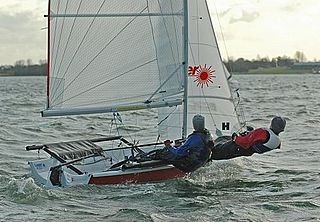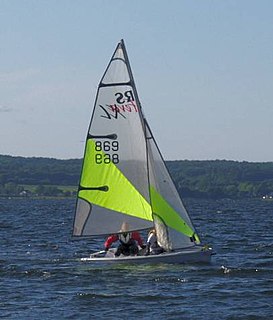
Dinghy sailing is the activity of sailing small boats by using five essential controls:
The Mirror is a popular sailing dinghy with more than 70,000 built.
The Portsmouth Yardstick (PY) or Portsmouth handicap scheme is a term used for a number of related systems of empirical handicapping used primarily in small sailboat racing.

The Wayfarer is a wooden or fibreglass hulled fractional Bermuda rigged sailing dinghy of great versatility; used for short 'day boat' trips, longer cruises and for racing. Over 11,000 have been produced as of 2016.

The Hobie Cat is a small sailing catamaran manufactured by the Hobie Cat Company. Hobie's line of products includes surfboards, sailboats, kayaks, stand-up paddle boards, and pedalboards, although the Hobie Cat Company is known worldwide for its catamarans. Hobie also designed a successful monohull, the Hobie 33.

The Laser 2 is a double-handed version of the popular Laser one-design class of small sailing dinghy. It is a quick, planing dinghy that differs from the Laser in that it has a jib, symmetric spinnaker and a single trapeze for the crew in the racing "Regatta" version. It was designed by New Zealander Frank Bethwaite and was first launched as a product in Australia then North America in 1979 and in Europe in 1980.

The Laser Pico dinghy is a small sailboat designed by Jo Richards in the mid-1990s and used primarily for training and day sailing. It can be crewed by one or two children or an adult. Current models come equipped with both a mainsail and a jib, the jib however mainly functions as a training tool and provides little to no contribution to speed. The Pico functions mainly as a training boat for younger children because of its very durable nature and has little to no racing events dedicated to it.

The Laser 4000 is a racing dinghy designed by Phil Morrison crewed by two persons. Its one-design weight-equalised system enables physically differing sailors to compete on a level playing field. It is most popular in Europe, particularly the UK, France and Italy.

The Merlin Rocket is a 14 foot (4.3 m) dinghy sailed in the United Kingdom. It is an active class, now with over 3700 boats built.

Otter is a classification referring to a particular design for a two-man sailing dinghy with a glass fibre hull. Its rig consists of a main, a jib and an optional symmetric spinnaker. The hull dimensions are 11 ft 11 in length and 4 ft 10 in beam. The boat has a draft of 3 ft 6 in with the centreboard down. The sail area is 75 sq. ft. The class symbol is a stylised glass bubble; due to the original lightweight "cigar box cedar" construction of the prototypes, the name 'Bubble' was first used for the boat. John Baker obtained the plans for an expanded version of the boat in G.R.P. and hence renamed the boat 'Glass Bubble'. After being put into production by Baker, the name 'Otter' was adopted; coming from the river of the same name in East Devon, close to where the boat was manufactured.

The Tempest is a trailerable, one-design racing sailboat that was designed by British naval architect Ian Proctor and first built in 1965.

The National Solo class is a racing dinghy designed by Jack Holt in 1956. The Solo is sailed in the United Kingdom, Holland, Portugal and Australia.
The RS Vareo is a modern, single-handed sailing dinghy raced throughout the UK at both club and national level. The RS Vareo is a hiking singlehander with an asymmetric spinnaker.

The Laser 3000 is a racing sailing dinghy crewed by two persons with a trapeze for the crew. Launched in 1996, the 3000 was developed from the Laser 2, using the original Frank Bethwaite-designed planing hull combined with a brand new self-draining deck by Derek Clark. Clark also re-designed the rig, using spars and sails from premium proprietary sources and replacing the symmetric spinnaker of the Laser 2 by a larger asymmetrical spinnaker. The gennaker is chute-launched and retrieved using a single halyard line, and is set on a retractable bowsprit. Helm balance and handling were improved using a shorter-footed mainsail with two full-width battens giving a larger roach. A mast with conventional spreaders replaced the now-unusual diamond arrangement of the Laser 2.

The RS Feva is a two-person sailing dinghy designed by Paul Handley in 2002. It is manufactured and distributed by RS Sailing. The RS Feva is an International Sailing Federation (ISAF) International Class, a Royal Yachting Association (RYA) Supported Junior Class, and has been selected by the Dansk Sejlunion and Norges Seilforbund for major sailing growth projects.

The 3000 is a racing sailing dinghy crewed by two persons with a trapeze for the crew. Launched in 1996 as the Laser 3000, the 3000 was developed from the Laser 2, using the original Frank Bethwaite-designed planing hull combined with a new designed self-draining deck by Derek Clark. Clark also re-designed the rig, using spars and sails from premium proprietary sources and replacing the symmetric spinnaker of the Laser 2 by a larger asymmetric spinnaker (gennaker). The gennaker is chute-launched and retrieved using a single halyard line, and is set on a retractable bowsprit. Helm balance and handling were improved using a shorter-footed mainsail with two full-width battens giving a larger roach. A mast with conventional spreaders replaced the now-unusual diamond arrangement of the Laser 2.

The Buzz is a sailing dinghy designed in 1994 by Ian Howlett and John Caig and manufactured by Reg White Limited of Brightlingsea as part of the "White Formula" range of boats originally marketed by Topper International Ltd but since 2013 by Vantage Sailing. The Buzz is a double handed racing boat, with a single trapeze for the crewman. The boat has a fully battened mainsail, furling jib and an asymmetrical spinnaker. There have been around 500 boats built. The Buzz is designed to be an easy to sail boat, but it can also be raced competitively.
ISO is an International Sailing Federation (ISAF) class of two-person sailing dinghy with a single trapeze and an asymmetric spinnaker. The ISO was designed in 1993 by Ian Howlett and John Caig and manufactured by Reg White Limited of Brightlingsea as part of the "White Formula" range of boats originally marketed by Topper International Ltd and since 2013 by Vantage Sailing Ltd. The boat has a fully battened mainsail, jib and an asymmetric spinnaker.

The Paceship PY 23 is a Canadian trailerable sailboat, that was designed by John Deknatel of C. Raymond Hunt Associates and first built in 1973.
The Isotope is an American catamaran sailing dinghy that was designed by Frank Meldau as a one-design racer and first built in 1962.
This page is based on this
Wikipedia article Text is available under the
CC BY-SA 4.0 license; additional terms may apply.
Images, videos and audio are available under their respective licenses.
















